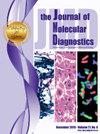A Dual-Mode Targeted Nanopore Sequencing Assay for Comprehensive SMN1 and SMN2 Variant Analysis
IF 3.4
3区 医学
Q1 PATHOLOGY
引用次数: 0
Abstract
Spinal muscular atrophy (SMA) is one of the most common recessive disorders, for which several life-saving treatment options are available. It is therefore essential to establish universal SMA screening and diagnostic programs using scalable, cost-effective, and accessible platforms to accurately identify all variation types. This task is complicated by high sequence homology between the SMN1 and SMN2 genes. Toward this goal, a dual-mode PCR-based target-enrichment method was developed, optimized, and evaluated in an external laboratory as a proof-of-concept for scalable and deployable any-length nanopore sequencing. The assay generates 2.7- to 11.2-kb amplicons spanning exons 3 to 8 of the SMN1 and SMN2 genes, which are then analyzed using a variant calling model that reports sequence and copy number variants specific to each gene from paralog-specific sequences and read-depth data. Overall, the assay detected single-nucleotide variants, insertions/deletions, and copy number variants with >98% genotype agreement across >750 samples, including cell lines, residual presumed-normal whole-blood donors, and patients with known SMN1 and SMN2 genotypes. The assay also demonstrated a dynamic sample throughput, 9-hour turnaround time, and 4-hour hands-on time. Together with the modest capital investment and consumable costs per sample, this assay can help to increase access to SMA testing in low- and middle-income settings. As a result, this PCR/Nanopore sequencing assay and analysis pipeline has the potential for universal implementation in SMA carrier screening and diagnostic programs.
一种用于SMN1和SMN2变异综合分析的双模式靶向纳米孔测序方法。
脊髓性肌萎缩症(SMA)是最常见的隐性遗传疾病之一,目前已有多种挽救生命的治疗方案。利用可扩展、高成本效益和可访问的平台建立通用的 SMA 筛查和诊断计划至关重要,以准确识别所有变异类型,而同源的 SMN1 和 SMN2 基因使这一问题变得复杂。为了实现这一目标,我们开发了一种基于 PCR 的双模式目标富集方法,并在外部实验室进行了优化和评估,作为可扩展和可部署的任意长度纳米孔测序的概念验证。该检测方法能产生跨越 SMN1 和 SMN2 基因第 3-8 号外显子的 2.7 至 11.2-kb 扩增子,然后使用变异调用模型对其进行分析,该模型能从旁族特异序列和读深数据中报告每个基因的特异序列和拷贝数变异。总体而言,该检测方法在 750 多个样本中检测到了单核苷酸变异、插入/缺失和拷贝数变异,基因型一致率大于 98%,这些样本包括细胞系、残留的假定正常献血者以及已知 SMN1 和 SMN2 基因型的患者。该测定还展示了动态样本吞吐量、9 小时的周转时间和 4 小时的操作时间。再加上每份样本的资金投入和耗材成本不高,该检测方法有助于提高中低收入地区的 SMA 检测普及率。因此,这种 PCR/纳米孔测序测定和分析流水线有望在 SMA 携带者筛查和诊断项目中得到普遍应用。
本文章由计算机程序翻译,如有差异,请以英文原文为准。
求助全文
约1分钟内获得全文
求助全文
来源期刊
CiteScore
8.10
自引率
2.40%
发文量
143
审稿时长
43 days
期刊介绍:
The Journal of Molecular Diagnostics, the official publication of the Association for Molecular Pathology (AMP), co-owned by the American Society for Investigative Pathology (ASIP), seeks to publish high quality original papers on scientific advances in the translation and validation of molecular discoveries in medicine into the clinical diagnostic setting, and the description and application of technological advances in the field of molecular diagnostic medicine. The editors welcome for review articles that contain: novel discoveries or clinicopathologic correlations including studies in oncology, infectious diseases, inherited diseases, predisposition to disease, clinical informatics, or the description of polymorphisms linked to disease states or normal variations; the application of diagnostic methodologies in clinical trials; or the development of new or improved molecular methods which may be applied to diagnosis or monitoring of disease or disease predisposition.

 求助内容:
求助内容: 应助结果提醒方式:
应助结果提醒方式:


